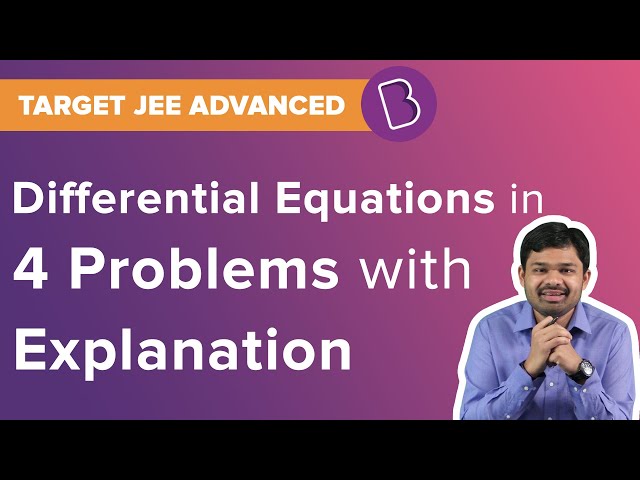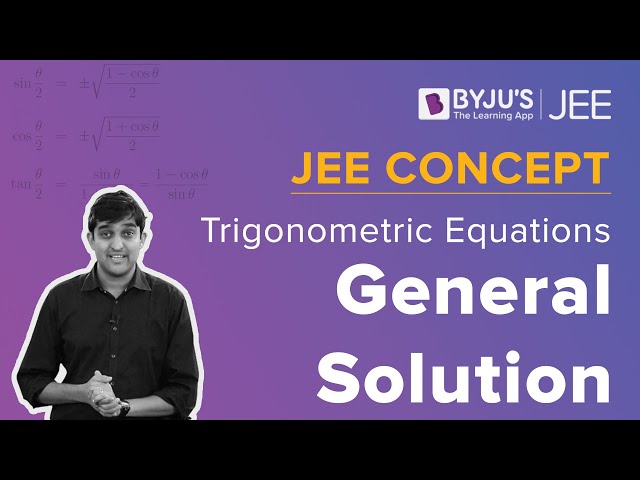a) 6
b) 10
c) 8
d) 5
T: (xx1/4)-(yy1/2) = 1..(1)
t: 2x-y = 0 is parallel to T
T: 2x-y = λ ..(2)
Now compare (1) and (2)
x1 ÷(4/2) = y1 ÷(2/1) = 1/λ
x1 = 8/λ and y1 = 2/λ
(x1, y1) lies on hyperbola
(64/4λ2) -(4/2λ2) = 1
14 = λ2
Now x12+5y12 = (64/λ2) +5(4/λ2)
= 84/14
= 6
Answer:(a)
a) (√17-1)/2
b) √17/2
c) (1+√17)/2
d) (√17/2)+1
-1≤ (|x|+5)/x2+1 ≤1
-x2-1≤|x|+5≤ x2+1
Case 1
-x2-1≤ |x|+5
This inequality is always right for all x∈R.
Case 2:
|x|+5 ≤ x2+1
x2-|x| ≥4
x2-x-4 ≥0
(|x|-(1+√17)/2)(|x|-(1-√17)/2) ≥0
|x|≤(1-√17/2) (Not possible)
Or |x| ≥ (1+√17/2)
x∈(-∞, (-1-√17)/2] U[(1+√17)/2, )
a = (1+√17)/2
Answer: (c)

be continuous for some a, b, c ∈ R and f’(0)+f’(2) = e, then the value of a is:
a) 1/(e2-3e+13)
b) e/(e2-3e-13)
c) e/(e2+3e+13)
d) e/(e2-3e+13)
f(x) is continuous
at x =1 At x = 1, b = ce – ae2
at x =3
9c = 9a+6c
c = 3a
Now f ’(0) +f ‘(2) = e
a-b+4c = e
a-e (3a-ae)+4×3a = e
a-3ae+ae2+12a = e
13a-3ae+ae2 = e
a = e/(13-3e+e2)
Answer: (d)
a) (-∞, -9]∪[3, ∞)
b) [-3, ∞)
c) (-∞, -9]
d) (-∞, -3]∪[9, ∞)
(a/r).a.ar = 27
a = 3
(a/r)+a+ar = S
(1/r)+1+r = S/3
r+(1/r) = (S/3)-1
r+(1/r) ≥ 2 or r+(1/r) ≤ -2
(S/3) ≥ 3 or (S/3) ≤ -1
S≥ 9 or S ≤ -3
S∈(-∞, -3]∪[9,∞)
Answer: (d)
a) {-1, 0, 1}
b) {-2, -1, 1, 2}
c) {0,1}
d) {-2,-1,0,1,2}
3y2 ≤ 8-x2
R:{(0,1), (0,-1), (1,0), (-1,0), (1,1), (1,-1), (-1,1), (-1,-1), (2,0), (-2,0), (2,1), (2,-1), (-2,1), (-2,-1)}
R: {-2, -1, 0, 1, 2} ->{-1,0,-1}
Hence R-1:{-1,0,1}-> {-2, -1, 0, 1, 2}
Answer: (a)
a) (-1/2)(1-i√3)
b) (1/2)(1-i√3)
c) (-1/2)(√3-i)
d) (1/2)(√3-i)

= (ei(5π/36)+i(5π/36))3
= (e2i(5π/36))3
= ei(30π/36)
= ei(5π/6)
= cos (5π/6)+ i sin 5π/6
= (-√3/2)+(i/2)
Answer: (c)
a) x+3y-62 = 0
b) x-3y-11 = 0
c) x-3y+22 = 0
d) x+3y+26 = 0
C: y = x2+7x+2
Let P : (h, k) lies on

Curve k = h2+7h+2 …(1)
Now for shortest distance
Slope of tangent line at point P = slope of line L
dy/dx at P(h,k) = mL
(d/dx)(x2+7x+2) at P(h,k) = 3
(2x+7)at P(h,k) = 3
2h+7 = 3
h = -2
from (1) k = -8
P: (-2, -8)
equation of normal to the curve is perpendicular to L: 3x-y = 3
N: x+3y = λ
Pass(-2,-8)
λ = -26
N: x+3y+26 = 0
Answer: (d)
(P) If A ≠I2 , then A = -1
(Q) If A =1 , then tr(A) = 2,
where I2 denotes 2×2 identity matrix and tr(A) denotes the sum of the diagonal entries of A. Then:
a) Both (P) and (Q) are false
b) (P) is true and (Q) is false
c) Both (P) and (Q) are true
d) (P) is false and (Q) is true
P: A =
And A ≠0 and A = 1 (False)
Q: A =
then Tr(A) = 2 (true)
Answer: (d)
a) 4/17
b) 8/17
c) 2/5
d) 2/3
Let P(I) represent probability of selecting box I and P(II) represent probability of selecting box II.
P(I) = 1/2
P(II) = 1/2
In Box I, prime numbers are {2,3,5,7,11,13,17,19,23,27}
In Box II, prime numbers are {31,37,41,43,47}
Let A be event that selected number on card is non prime.
P(A) = P(I).P(A/I)+P(II).P(A/II)
= (1/2)×(20/30)+(1/2)×(15/20)
= 17/24
Now, P(I/A) = P(II).P(A/I)÷P(A)
= (1/2)×(20/30)÷ (17/24)
= (1/3)×(24/17)
= 8/17
Answer: (b)
a) 12
b) -12
c) -24
d) 6
p’(1) = 0 and p’(2) = 0
p’(x) = a(x-1)(x-2)
p(x) = a[(x3/3)-(3x2/2)+2x]+b
p(1) = 8
a[(1/3)-(3/2)+2]+b = 8 ..(i)
p(2) = 4
a[(8/3)-(3×4/2)+2×2]+b = 4 ..(ii)
From equation (i) and (ii)
a = 24 and b = -12
p(0) = b = -12
Answer: (b)
a) If I will catch the train, then I reach the station in time.
b) If I do not reach the station in time, then I will catch the train.
c) If I do not reach the station in time, then I will not catch the train.
d) If I will not catch the train, then I do not reach the station in time.
Statement p and q are true
Statement, then the contra positive of the implication
p->q = (~q) ->(~p)
Answer: (d)
a) 5S6+6S5+2S4 = 0
b) 6S6+5S5 = 2S4
c) 6S6+5S5+2S4 = 0
d) 5S6+6S5= 2S4
5x2+6x-2 = 0
Put x = α
5α2+6α-2 = 0
6α-2 = -5α2 ..(i)
Similarly
6β-2 = -5β2 ..(ii)
S6 = α6+β6
S5 = α5+β5
S4 = α4+β4
Now 6S5-2S4 = 6α5+6β5-2α4-2β4
= α4(6α-2)+β4(6β-2)
= α4(-5α2)+β4(-5β2)
= -5(α6+β6)
= -5S6
Hence 6S5+5S6= 2S4
Answer: (d)
a) b = (π/2)+a
b) |a+b| = 1
c) |b-a| = 1
d) b = a
(dy/dx)p(a,b) = (2-3/2)/(1/2 -0)
1+cos b = 1. p: (a,b) lies on curve
cos b = 0
b = a+sin b
b = a
b-a =
|b-a| = 1
Answer: (c)
a) 3(π-2)
b) 6(π-2)
c) 6(4-π)
d) 3(4-π)

Given (x/2)+ (y/3) = 1
A = 4((πab/4)-(1/2)×2×3)
= π×2×3-12
= 6(π-2)
Answer: (b)
a) (x+y+xy)/(1-x)(1-y)
b) (x+y-xy)/(1-x)(1-y)
c) (x+y+xy)/(1+x)(1+y)
d) (x+y-xy)/(1+x)(1+y)
(x+y)+(x2+xy+y2)+(x3+x2y+xy2+y3)+….. ∞
= (1/x-y){(x2-y2)+(x3-y3)+(x4-y4)+…..∞
= (x2/(1-x)) -(y2/(1-y))/(x-y)
= {x2(1-y)-y2(1-x)}/(1-x)(1-y)(x-y)
= ((x+y)-xy)(x-y)/(1-x)(1-y)(x-y)
= (x+y-xy)/(1-x)(1-y)
Answer: (b)
a) 176
b) 336
c) 352
d) 84
For term independent of x
Tr+1 = 10Cr(αx1/9 )10-r(βx-1/6)r
= 10Crα10-rβr.x(10-r)/9.x-r/6
Since (10-r)/9-(r/6) = 0
r = 4
T5 = 10Crα6.β4
AM≥GM
Now
Take 4th power
(4/4)4 ≥ (α6β4/24)
α6.β4 ≤ 24
10C4α6.β4≤ 10C424
T5 ≤ 10C424
T5 ≤ 10!24/(6!4!)
T5 ≤ (10×9×8×7×24)/(4×3×2×1)
Maximum value of T5 = 10×3×7×16 = 10k
k = 3×7×16
k = 336
Answer: (b)
2x-y+2z = 2
x-2y+λz = -4
x+λy+z=4
has no solution. Then the set S
a) is an empty set.
b) is a singleton.
c) contains more than two elements.
d) contains exactly two elements.
For no solution
Δ= 0
Δ =
2(-2-λ2)+1(1-λ)+2(λ+2) = 0
-4-2λ2+1-λ+2λ+4 = 0
2λ2-λ-1 = 0
λ= 1 or -1/2
For two values of λ, equations has no solution.
Answer (d)
a) -27
b) 7
c) -7
d) 9
X :{1,2,…17}
Y: {ax+b:x∈X and a,b∈R, a>0}
Given var(Y) = 216
(Ʃy12)/n – mean2 = 216
(Ʃy12)/17 – 289 = 216
(Ʃy12) = 8585
(a+b)2 +(2a+b)2+….+(17a+b)2 = 8585
105a2 +b2+18ab=505 ..(1)
Now Ʃy1 = 17×17
a(17×9) + 17.b = 17×17
9a+b = 17 ….(2)
from equation (1) & (2)
a = 3 and b = -10
a+b = -7
Answer (c)
a) (2,2/3)
b) (1,1)
c) (2,1)
d) (1,-1)
∫(dy/y+1) = ∫-cos x/(2+sin x)dx
ln |y+1| = -ln |2+sin| x +k
Put (0,1)
k = ln 4
Now C: (y+1)(2+sin x) = 4
y(π) = a (a+1)(2+0) = 4
⇒ a = 1
(dy/dx)x=π = b
⇒ b = -(-1)(2+0)/(1+1)
= 1
(a,b) = (1,1)
Answer: (b)
a) (0,-6,2)
b) (0,6,-2)
c) (-2,0,1)
d) (2,0,-1)

Given lines are 2x = 3y, z = 1
Dr of line (3,2,0)
Plane : -2(x-1)+3(y-2)+5(z -1) = 0
Plane : -2x+3y+5z+2-6-5=0
Plane : 2x-3y-5z = -9
Answer: (c)

c: (1,2) and r = 1
cp < r
|(3×1+4×2-k)/5| < 1
|11-k| < 5
-5<k-11<5
6<k<16
k = 7,8,9,..,15
So total 9 value of k.
Answer: (9)
a2+b2-2a.b+a2+c2-2a.c = 8
2a2+b2+c2-2a.b -2a.c=8
a.b+a.c = -2
Now
= 2a2+4b2+4c2+4a.b+4a.c
= 2+4+4+4(-2)
= 2
Answer: (2)

Answer: (309)
Given
1+2+3+…+n = 820
Ʃn = 820
n(n+1)/2 = 820
n = 40
Answer: (40)
=
=
=
= [(1/2)-0-(1/4)-0]+(1-(1/4))-(1-(1/2))+1
= (1/2)-(1/4)+(3/4)-(1/2)+1
= 3/2
Answer (3/2)
Video Lessons – Maths




JEE Main 2020 Maths Paper With Solutions Sep 2 Shift 1













Comments